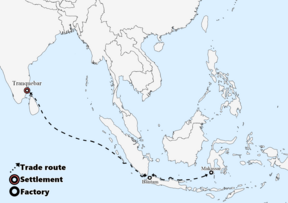User:Tinkaer1991/War between Tranquebar and Thanjavur
| Assault on Osu | |||||||
|---|---|---|---|---|---|---|---|
 Christiansborg Castle and Osu, 18th century | |||||||
| |||||||
| Belligerents | |||||||
|
|
Supported by: Des Bordes | ||||||
| Commanders and leaders | |||||||
|
|
| ||||||
| Units involved | |||||||
|
| Unknown | ||||||
| Strength | |||||||
|
Unknown amount of men Multiple guns | Unknown | ||||||
| Casualties and losses | |||||||
| Unknown | Heavy | ||||||
The Sieges of Tranquebar (Danish; Belejringerne af Trankebar) refers to the warfare between the Thanjavur Nayak kingdom and Danish Tranquebar between 1655 – 1669. The Thanjavurian sieges were repelled, mainly due to the new fortifications being build around Tranquebar, and a peace agreement is issued in 1669.
Background[edit]
In 1643 the vessel Christianshavn would arrive in Tranquebar with proclaimed governor, Willem Leyel.[1][2] Unbeknownst to the Danes in India would be that, this was the last ship from Denmark for 26 years:[3][4][5] Because of the Dano-Swedish Wars Denmark did not have the means to send any new ship to India, so Tranquebar could therefore not be assited from Denmark.[3] This led to financial difficulties and a general lack of Danish manpower.[2]
In 1648 a mutiny broke out in Tranquebar and Leyel was subsequently arrested.[2][6] He was succeded by Poul Hansen Korsør,[a] who reigned until his death on 7 September 1655.[7] Furthermore the first Danish East India Company was dissestablished in 1650, and the number of Danes remained only a handful.[8]
Arriving together with the Christianshavn in 1643,[5][9] Eskild Andersen (Kongsbakke) now became the new governor of Tranquebar.[10][9] Andersen would try to preserve the economy by regularly sending ships to Makassar and Bantam, and wage privateering against the Mughal Empire.[9]
Sieges[edit]
The Nayak of the Thanjavur kingdom, Vijaya Raghava, had waged war against the Gingee and Madurai and therefore needed sufficient money.[8] The Thanjavurians took advantage of a weakened Tranquebar and in 1655 demanded to raise the early tribute paid by Tranquebar.[11][12] When Tranquebar failed to fulfill this demand Raghava sent a force to besiege Tranquebar.[9] Though, Andersen defended the attack by the help of the local Indians: The number of Danish settlers in Tranquebar was very small, and it was therefore necessary to hire Portuguese mercenaries and Indian Sepoys to defend Fort Dansborg.[9]
In 1660 a new siege was initiated, which would last nine months.[9][8] In response Andersen started to fortify the whole town.[13] Previously Dansborg had been the only fortified place, and the Inhabitants of Tranquebar would usually seek shelter in the fort.[12] This was now changed, and all of Tranquebar was fortified.[12] Andersen made the locals build a Curtain wall around the city, with four additional towers.[8]
In May 1669 the 29-year-isolation was over with the arrival of the frigate Farø at Tranquebar.[9][11] Færø arrived with soldiers and goods under the command of Henrik Eggers.[10] As a result of Færø's arrival peace was concluded with Vijaya Raghava.[11]
Aftermath[edit]
As a result of the peace the nayak ceded the villages of Poreiar, Tillali and Erikutanchery, which greatly enlargened Tranquebar.[11] Meanwhile, Færø would be sent to Java to reestablish trade connections with the local sultan.[11]
Notelist[edit]
References[edit]
- ^ Sejerø, Olav. "Trankebarmønter med Skibsnavne". sejeroe.com. Retrieved 2024-04-18.
- ^ a b c Bredsdorff, Asta (2009). The Trials and Travels of Willem Leyel. Copenhagen: Museum Tusculanum Press.
- ^ a b "Tranquebar-mønter, 1620-1670". danmarkshistorien.dk (in Danish). Retrieved 2024-04-18.
- ^ "Danmarks koloni i Tranquebar 1616-1729 - Rigsarkivet - kilderne.dk". Kilderne (in Danish). Retrieved 2024-04-18.
- ^ a b Ritzau (2020-10-17). "Eskild var den eneste dansker i Trankebar". Sjællandske Nyheder (in Danish). Retrieved 2024-04-18.
- ^ Holbek, Finn. "Skeel, Schaffalitzky og Ahlefeldt". finnholbek.dk (in Danish). Retrieved 2024-04-18.
- ^ "P. H. Korsør - www.foreningen-trankebar.dk". 123hjemmeside.dk (in Danish). Retrieved 2024-04-18.
- ^ a b c d "Eskild alene i Tranquebar". videnskab.dk (in Danish). 2023-06-14. Retrieved 2024-04-18.
- ^ a b c d e f g "Den danske tropekoloni i Trankebar". www.aerenlund.dk. Retrieved 2024-04-18.
- ^ a b "E.A.Kongsbakke - www.foreningen-trankebar.dk". 123hjemmeside.dk (in Danish). Retrieved 2024-04-18.
- ^ a b c d e Gregersen, Hans (2018). Trankebar [Tranquebar] (in Danish). Forlag A/S. pp. 12–13. ISBN 9788711978337.
- ^ a b c "Bogstaver på Frederik den Tredies blymønter". danskmoent.dk. Retrieved 2024-04-18.
- ^ Westerbeek, Bjørn. Omkring et par tidlige kort over Tranquebar (in Danish). Københavns Rådhusbibliotek. p. 28.

